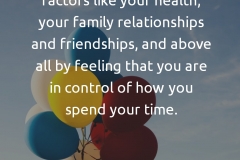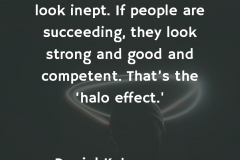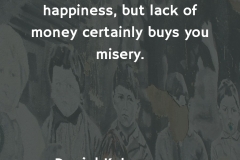The Halo Effect

The Halo Effect | Painting: Saint Lawrence by Bonanat Zaortiga
Don’t put people, or anything else, on pedestals, not even your children. Avoid global labels such as genius or weirdo. Realize those closest get the benefit of the doubt and so do the most beautiful and radiant among us. Know the halo effect causes you to see a nice person as temporarily angry and an angry person as temporarily nice. Know that one good quality, or a memory of several, can keep in your life people who may be doing you more harm than good. Pay attention to the fact that when someone seems nice and upbeat, the words coming out of his or her mouth will change in meaning, and if that same person were depressive, arrogant, or foul in some other way, your perceptions of those same exact words would change along with the person’s other features.
David McRaney
If people are failing, they look inept. If people are succeeding, they look strong and good and competent. That’s the ‘halo effect.’ Your first impression of a thing sets up your subsequent beliefs. If the company looks inept to you, you may assume everything else they do is inept.
The halo effect, also known as physical attractiveness stereotype, refers to the tendency to use one trait of a person or thing to pass an overall judgment of them. For instance, attractive people may look smart and honest without any logical reasons. Celebrities, for example, are often perceived to be kind and smart, just because of their attractiveness. Another good example is that we may believe that because a person is good at doing A, therefore they will be equally good at doing B, or vice versa: Because something is bad in C, it will be also bad in D.
The term was first used in ‘A Constant Error in Psychological Ratings’, an article by Edward Thorndike in 1920. According to the paper, “…. in a study made in 1915 of employees of two large industrial corporations, it appeared that the estimates of the same man in a number of different traits such as intelligence, industry, technical skill, reliability, etc., were very highly correlated and very evenly correlated… Ratings were apparently affected by a marked tendency to think of the person in general as rather good or rather inferior and to color the judgments of the qualities by this general feeling. This same constant error toward suffusing ratings of special features with a halo belonging to the individual as a whole appeared in the ratings of officers made by their superiors in the army.”
The extent of this effect can easily be traced in the workplace as well. As Schneider, Gruman and Coutts state in their book, “…in the work setting, the halo effect is most likely to show up in a supervisor’s appraisal of a subordinate’s job performance. In fact, the halo effect is probably the most common bias in performance appraisal. Think about what happens when a supervisor evaluates the performance of a subordinate. The supervisor may give prominence to a single characteristic of the employee, such as enthusiasm, and allow the entire evaluation to be colored by how he or she judges the employee on that one characteristic. Even though the employee may lack the requisite knowledge or ability to perform the job successfully, if the employee’s work shows enthusiasm, the supervisor may very well give him or her a higher performance rating than is justified by knowledge or ability.”
During election campaigns, we may pick a candidate for presidency just because we believe in his or her veracity. The fact that the candidate is truthful is a very great personal trait, but it does not necessarily mean that they will be good presidents as well.
Also watch
Further reading
Very Well Mind |The halo effect
Examples of the Halo Effect in the Workplace
The Halo Effect: How it Affects Marketing and UX
McKinsey | The halo effect, and other managerial delusions







